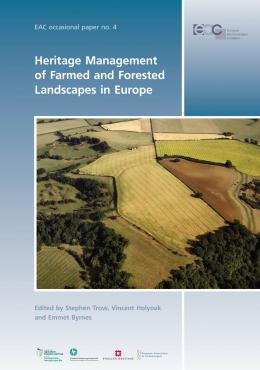Heritage Management of Farmed and Forested Landscapes in Europe

Heritage Management of Farmed and Forested Landscapes in Europe
| 9 670 Ft |
| Price |
European Archaeological Council Occasional Paper No. 4
Budapest, Archaeolingua, 2010
Keménykötés | Hardcover
184 oldal, színes és fekete-fehér illusztrációkkal | 184 pages with colored and grayscale images
ISBN 978 963 9911 17 8
The digital version of the book is available in pdf on the EAC website.
Description
Some 40 percent of Europe is farmed and 47 percent forested. The future of the majority of Europe’s archaeological sites therefore depends on rural land uses that lie outside the spatial planning and development control systems of its various nation states. This volume, produced by the European Association of Archaeologists (EAA) and Europae Archaeologiae Consilium (EAC) Joint Working Group on Farming, Forestry and Rural Land Management, examines the challenges posed by agriculture, forestry and other rural land uses in terms of the long-term conservation of Europe’s archaeological sites and the management of its historic landscapes. Profusely illustrated and with contributions from no fewer than 13 different European countries, the volume will be essential reading for anyone concerned with contemporary heritage management, policy-making and legislation.
Table of Contents
Foreword
Katalin Wollák, President of Europae Archaeologiae Consilium
Introduction
Stephen Trow
European Overview
1. Farming, forestry, rural land management and archaeological historical landscapes in Europe
Stephen Trow
National and Local Perspectives
2. Challenges related to archaeological heritage preservation in the Norwegian rural landscape
Ingrid Smedstad
3. Problems and perspectives of archaeological heritage preservation in farmed landscapes in Germany – a survey of federal structures
Andreas Büttner, Jana Esther Fries, Henning Hassmann, Gabriele Schiller, Michael Strobel and Thomas Westphalen
4. Shaping the Netherlands
Cees van Rooijen and Guido Mauro
5. Raising consciousness: the reconciliation of archaeological- heritage preservation and agricultural practice in Hungary
Réka Virágos
6. Agricultural changes, ancient mounds, and archaeological course-corrections: some field (and forest) notes from southern Burgundy
William Meyer
7. Cover is not shelter: archaeology and forestry in the Czech Republic
Zdeněk Neustupný
8. Environmental monitoring of archaeological deposits
Vibeke Vandrup Martens
9. Monitoring and managing archaeological sites on the farmland of Wales
Peter Gaskell and Gwilym Hughes
10. Field Monument Wardens in Northern Ireland: working with owners to manage scheduled historic monuments
Claire Foley
11. The Field Monument Advisory Scheme in the Republic of Ireland
Rosanne Meenan
12: Assessing and managing risk: the Scheduled Monuments At Risk (SMAR) and Conservation Of Scheduled Monuments In Cultivation (COSMIC) projects, England:
Jon Humble
13. The Rural Environment Protection Scheme (REPS) and archaeology
Hugh Carey and Ann Lynch
14. Archaeology, agriculture and environment on the Burren Uplands, Ireland
Christine Grant
15. Heritage stewardship in Flanders: rural development money for rural heritage management?
Karl Cordemans
16. Agri-environmental schemes and the historic environment of the United Kingdom: a view from Wales
Mike Yates, with contributions from Victoria Hunns, Rhonda Robinson, and Jonathan Wordsworth
17. Ripping up history, sordid motives or cultivating solutions? Plough damage and archaeology: a perspective from England
Stephen Trow
18. Mitigation impossible? Practical approaches to managing archaeology in arable farming systems
Vince Holyoak
19: Forestry and the historic environment in Britain: a challenging past and an exciting future
Tim Yarnell and Peter Crow
20: Forestry and archaeology in Ireland: current practice and future trends
Emmet Byrnes
21. Archaeology and forestry in Bavaria (Germany): current ways of co-operation
Joachim Hamberger, Walter Irlinger and Grietje Suhr
Looking to the Future
22. Changing the land – the implications of climate-change policies, actions and adaptations for Scotland’s rural historic environment
Jonathan Wordsworth
23. The impoverishment of heritage in the European landscape – with some Swedish examples
Leif Gren and Peter Norman
Résumés/Zusammenfassungen
| |
|
|
1067 Budapest, Teréz krt. 13. |
|
|
|
|
About us
The Archaeolingua Foundation and Publisher is involved in publishing series and standalone publications in the disciplines of archaeology, linguistics, historic sciences and heritage protection for over 25 years.
Learn more
Publishing
We publish both as standalone editions and as a volume of a professional series.
Learn more
Contact us
Archaeolingua Foundation

